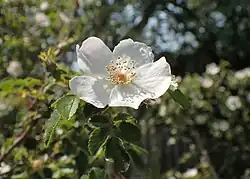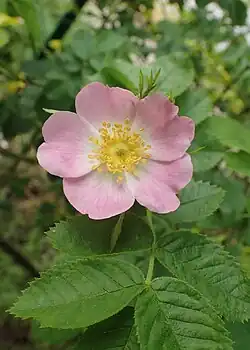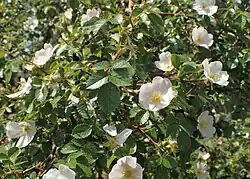Rosa micrantha
| Rosa micrantha | |
|---|---|
.jpg)
| |
| In bloom | |
| Scientific classification | |
| Kingdom: | Plantae |
| Clade: | Tracheophytes |
| Clade: | Angiosperms |
| Clade: | Eudicots |
| Clade: | Rosids |
| Order: | Rosales |
| Family: | Rosaceae |
| Genus: | Rosa |
| Species: | R. micrantha
|
| Binomial name | |
| Rosa micrantha | |
| Synonyms[1] | |
|
List
| |
Rosa micrantha, the small-flowered sweet briar, is a species of flowering plant in the family Rosaceae.[2] It is native to most of Europe, the Atlas Mountains of Africa, the Caucasus region, Turkey, Lebanon, and Syria, and it has been introduced to eastern North America, Argentina, and New Zealand.[1] A shrub reaching 3.5 m (11 ft), it is not readily available in commerce.[3]
-
 Close-up of flower
Close-up of flower -
 Flowers can be pink
Flowers can be pink -
 Flowers and foliage
Flowers and foliage -
.jpg) Hips
Hips -
.jpg) Hips remain after leaves abscise
Hips remain after leaves abscise -
.jpg) Botanical illustration
Botanical illustration
Genetics
Unlike some other species in Rosa sect. Caninae which are pentaploid with an unusual meiosis referred to as permanent odd polyploidy, R. micrantha has been found to be hexaploid with fully sexual reproduction.[4]
References
- ^ a b "Rosa micrantha Borrer ex Sm". Plants of the World Online. Royal Botanic Gardens, Kew. Retrieved 31 August 2022.
- ^ "Rosa micrantha small-flowered sweet briar". The Royal Horticultural Society. 2022. Retrieved 31 August 2022.
- ^ "Trees and shrubs: native to Britain". The Royal Horticultural Society. 2022. Retrieved 31 August 2022.
- ^ Christiane Mritz and Volker Wissemann (2011), Microsatellite Analyses of Artificial and Spontaneous Dogrose Hybrids Reveal the Hybridogenic Origin of Rosa micrantha by the Contribution of Unreduced Gametes, doi:10.1093/jhered/esq124